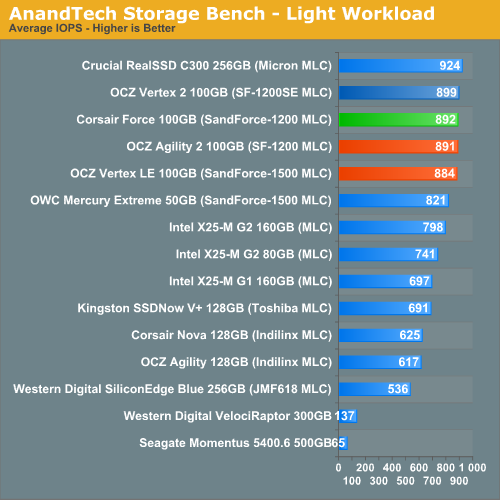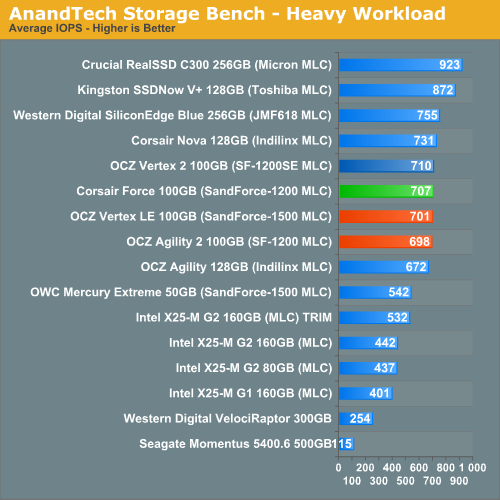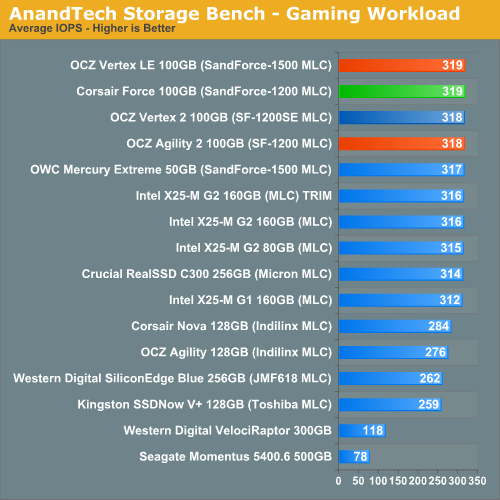OCZ's Vertex 2, Special Sauce SF-1200 Reviewed
by Anand Lal Shimpi on April 28, 2010 3:17 PM ESTAnandTech Storage Bench
Note that our 6Gbps controller driver isn't supported by our custom storage bench here, so the C300 results are only offered in 3Gbps mode.
The first in our benchmark suite is a light usage case. The Windows 7 system is loaded with Firefox, Office 2007 and Adobe Reader among other applications. With Firefox we browse web pages like Facebook, AnandTech, Digg and other sites. Outlook is also running and we use it to check emails, create and send a message with a PDF attachment. Adobe Reader is used to view some PDFs. Excel 2007 is used to create a spreadsheet, graphs and save the document. The same goes for Word 2007. We open and step through a presentation in PowerPoint 2007 received as an email attachment before saving it to the desktop. Finally we watch a bit of a Firefly episode in Windows Media Player 11.
There’s some level of multitasking going on here but it’s not unreasonable by any means. Generally the application tasks proceed linearly, with the exception of things like web browsing which may happen in between one of the other tasks.
The recording is played back on all of our drives here today. Remember that we’re isolating disk performance, all we’re doing is playing back every single disk access that happened in that ~5 minute period of usage. The light workload is composed of 37,501 reads and 20,268 writes. Over 30% of the IOs are 4KB, 11% are 16KB, 22% are 32KB and approximately 13% are 64KB in size. Less than 30% of the operations are absolutely sequential in nature. Average queue depth is 6.09 IOs.
The performance results are reported in average I/O Operations per Second (IOPS):

If there’s a light usage case there’s bound to be a heavy one. In this test we have Microsoft Security Essentials running in the background with real time virus scanning enabled. We also perform a quick scan in the middle of the test. Firefox, Outlook, Excel, Word and Powerpoint are all used the same as they were in the light test. We add Photoshop CS4 to the mix, opening a bunch of 12MP images, editing them, then saving them as highly compressed JPGs for web publishing. Windows 7’s picture viewer is used to view a bunch of pictures on the hard drive. We use 7-zip to create and extract .7z archives. Downloading is also prominently featured in our heavy test; we download large files from the Internet during portions of the benchmark, as well as use uTorrent to grab a couple of torrents. Some of the applications in use are installed during the benchmark, Windows updates are also installed. Towards the end of the test we launch World of Warcraft, play for a few minutes, then delete the folder. This test also takes into account all of the disk accesses that happen while the OS is booting.
The benchmark is 22 minutes long and it consists of 128,895 read operations and 72,411 write operations. Roughly 44% of all IOs were sequential. Approximately 30% of all accesses were 4KB in size, 12% were 16KB in size, 14% were 32KB and 20% were 64KB. Average queue depth was 3.59.

The gaming workload is made up of 75,206 read operations and only 4,592 write operations. Only 20% of the accesses are 4KB in size, nearly 40% are 64KB and 20% are 32KB. A whopping 69% of the IOs are sequential, meaning this is predominantly a sequential read benchmark. The average queue depth is 7.76 IOs.











44 Comments
View All Comments
ScottHavens - Wednesday, April 28, 2010 - link
In the article, it was suggested that random data is not representative of what users will see. While the current sizes of drives may make that true, the importance of performance under loads of random data will become more important with time and with the growth of drive sizes. Why? Users will start to store a larger percentage of already-compressed files, like mp3s and movies, on their SSDs instead of buying additional bulk drives, and compressed files are, by nature, effectively identical to random data.ggathagan - Wednesday, April 28, 2010 - link
Anand made two important distinctions: *small* and *writes*.He wasn't referring to all random data, regardless of size, and wasn't referring to reads.
Those are important qualifications. Most mp3 files, and certainly movies fall under the *large* file size.
Additionally, the vast amount of activity with those types of files are going to be reads, not writes.
Lonyo - Wednesday, April 28, 2010 - link
Not to mention that compressed files such as XviD/etc films won't see anywhere near as much benefit from an SSD in the first place.Sure, your read/write speeds might double or triple, but when it comes to sequential activities, mechanical drives are fast. SSDs excel at random reads/writes, which large files don't have so much of, since it's typically stored in a big chunk, meaning sequential activity, not random. And that's only a copying scenario.
The point at which an SSD becomes useful for such large files will be further away than the point at which it becomes viable for a wider range of files. I would transfer my games to a large SSD long before I would start transferring compressed media files. They can stay on a mechanical for a loooooong time.
When we do finally have large enough drives that they might be the primary storage drives, I doubt Sandforce will necessarily be applying the same ideas, and if they are, they will have progressed significantly from their current state.
Talking about applying a realistic future problem to drives which exist today is meaningless when you consider how much progress has been already made up the this point, and how much progress will be made between now and when the future issue actually becomes a reality (when SSDs are affordable for mass storage purposes).
ScottHavens - Wednesday, April 28, 2010 - link
I'm not arguing about whether a particular disclaimer in the article was completely accurate. My primary point was that it's not unheard of for people to use only one drive and still have a significant portion of their data compressed, and the number of people affected by this will likely increase over time. Further, I missed a key scenario that other posters have mentioned: file/partition encryption would likely be affected as well, and it's reasonable to assume that scenario will become more common as well as disk-level encryption becomes easier and even required by some companies.Further, I should point out that the problem (insofar as it is one) by no means affects only small writes. Large reads, according to the tables, have a 20% perf hit, and large writes have a 43% perf hit.
I don't intend to denigrate SandForce's methods here, by any means. If it helps, it helps, and I'll probably get at least one of these myself. I'm just pointing out that the 'YMMV' caveat is applicable to more people and situations than some people realize.
TSnor - Wednesday, April 28, 2010 - link
Re: Encryption and point that encrypted data doesn't compress. This is true, but... the SF controller self encrypts. There is little/no point in doing software full disk encryption before sending the data to the SF controller to be encrypted. SF-1200 uses 128 bit AES which NIST counts as strong encryption.ScottHavens - Wednesday, April 28, 2010 - link
Unfortunately, the only way to use that encryption is to use the device (ATA) password. Management and real-world usage of that is a pain and not nearly as flexible as the options available with, say, BitLocker. I'd wager that most companies with OS-level encryption policies in place will want to continue with their current policies rather than make exceptions for using ATA passwords with drives like this, even if the quality of the encryption itself is just as good.beginner99 - Thursday, April 29, 2010 - link
Stupid question:Can I unplug my sandforce drive and put it in an other computer and read the data without knowing the encryption password?
if yes isn't then the drives native encryption useless?
ScottHavens - Thursday, April 29, 2010 - link
No, you'll be required to enter a password on startup.arehaas - Wednesday, April 28, 2010 - link
Most laptops, including mine, allow for only one HD. I bought a Corsair F200 (before Anand reported the compressed file issue) and planned to keep my jpg photos, mp3s, some movies on the laptop attached to a TV (or a receiver). I think this is a reasonably common scenario. Users are already dealing big time with large compressed files which are slower sequentially on Sandforce than on Indilinx.I wish Crucial fixed their firmware sooner because C300 256GB is about $50 cheaper than F200 or Vertex 2 and faster in all dimensions.
beginner99 - Thursday, April 29, 2010 - link
get a cheap small external hdd if your concerned about this. But generally I would not consider mp3's and jpgs as large files.Yes, compressed but by no means large.Yeah many small laptops only have 1 hdd/sdd. It's IMHO stupid. would be much better to have space for 2 and just ship an external dvd drive. i mean i need my drive like once every couple month. completely useless if you have to carry it around all the time. (that's one great thing about the hp envy 15) ;)